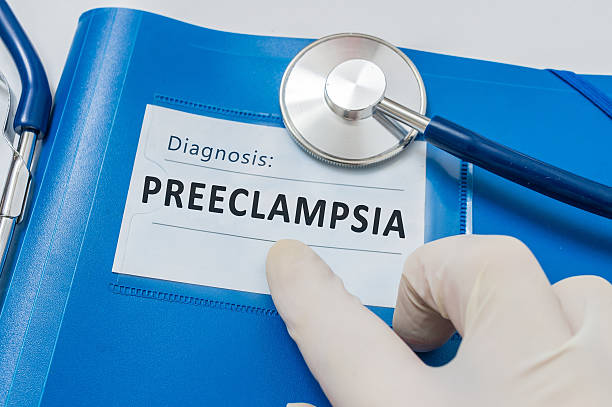
Unfortunately, high blood pressure can be dangerous to the mother and baby. Pre- eclampsia is one such high blood pressure (hypertension) disorder that can occur during pregnancy.
Pre- eclampsia is a rare but serious condition that can develop at any time during pregnancy but is more common toward the end. High blood pressure is the first tell-tale sign. Pre-eclampsia occurs in around 1 in 50 pregnancies and is one of the most common life-threatening conditions occurring in pregnancy.
Pre-eclampsia is thought to be caused by the placenta not developing properly due to a problem with the blood vessels supplying it. The exact cause isn't fully understood though.
Symptoms of Pre-Eclampsia
Pre-eclampsia rarely happens before the 20th week of pregnancy. Generally, the earlier pre-eclampsia develops, the more severe the condition will be.
Initially, pre-eclampsia causes:
- high blood pressure (hypertension)
- protein in the urine (proteinuria)
Though one wouldn’t notice any of these symptoms, the GP will pick them up during routine antenatal appointments.
High blood pressure alone doesn't suggest pre-eclampsia. But if protein in the urine is found at the same time as high blood pressure, it's a good indicator of the condition.
As pre-eclampsia progresses, it may cause:
- severe headaches
- vision problems, such as blurring or seeing flashing lights
- pain just below the ribs
- vomiting
- sudden swelling of the feet, ankles, face, and hands
Without immediate treatment, pre-eclampsia can lead to a number of serious complications, including:
- Convulsions (eclampsia)
- HELLP syndrome (a combined liver and blood clotting disorder)
- Stroke
Some of the risk factors for PE include:
- maternal and paternal family history
- previous pregnancy with pre-eclampsia
- multiple pregnancies (e.g., twins)
- maternal age (over 40 years)
- body mass index (BMI) over 30
- pre-existing high blood pressure, diabetes, smoking, or kidney disease
- systemic inflammation
- ethnic origin.
Pre-eclampsia Screening
Screening during the first trimester can identify women at high risk for pre-eclampsia. This potentially improves the pregnancy outcome because better maternal and fetal monitoring would lead to earlier detection of the clinical signs of the disease and where necessary medication can be given.
Screening is a simple way to identify your risk of developing early-onset pre-eclampsia. Early detection and treatment can protect your baby and improve pregnancy outcomes. Without intervention, PE may affect the normal growth of the baby.
Screening includes:
- Blood collected between 11-13+6 weeks (compared with 9+0-13+6 weeks for CFTS alone) to measure serum pregnancy-associated plasma protein-A (PAPP-A) and placental growth factor (PIGF) in maternal blood.
- In some cases, an ultrasound scan to measure the placental blood flow may also be performed.
These results are combined with maternal blood pressure and family history information to provide a result.
A woman who may have signs of early or mild pre-eclampsia will have her blood tested to detect additional signs of preeclampsia. A woman who has preeclampsia may have specific blood tests to help assess her health.
- Uric acid
Increased uric acid in the blood is often the earliest laboratory finding related to preeclampsia. But if the kidneys have been damaged by preeclampsia, uric acid levels in the blood may rise.
- Haematocrit
A high haematocrit value can be a sign of preeclampsia. Haematocrit tells the percentage of red blood cells in the blood. During pregnancy, the haematocrit value normally decreases and the fluid in the blood (plasma) increases, making red blood cells less concentrated. But pre-eclampsia often causes the body's tissues to absorb blood plasma. The blood becomes more concentrated, resulting in an abnormally high haematocrit value.
- Platelets
The number of platelets in the blood should be measured because pre-eclampsia may cause an abnormally low platelet count.
- Partial thromboplastin time (PTT)
This is a measure of the time it takes blood to clot. Pre-eclampsia can cause problems with blood clotting that increase the partial thromboplastin time.
- Electrolytes
Important electrolytes include sodium, potassium, magnesium, calcium, and chloride. The amounts of electrolytes in the body may change if pre-eclampsia is causing kidney damage or is causing fluid leaks out of blood vessels into surrounding tissues.
- Kidney function tests
These tests check the number of certain substances found in the blood that are normally removed from the body by the kidneys.
- Liver function tests
These tests monitor enzymes that indicate how well the liver is working.
Briefly
Pre-eclampsia is a condition that is specific to pregnancy and is diagnosed when a pregnant woman has high blood pressure and other clinical signs after 20 weeks of gestation. Although high blood pressure before pregnancy is one risk factor for preeclampsia, most women who develop preeclampsia never had high blood pressure and may have had low blood pressure before pregnancy.
Pre-eclampsia can also develop postpartum. So, if you develop any of these symptoms after you give birth, check in with your healthcare provider immediately.
If left untreated and unmonitored, preeclampsia can progress into more serious conditions that can put the mother and baby at risk for serious complications or even death.

